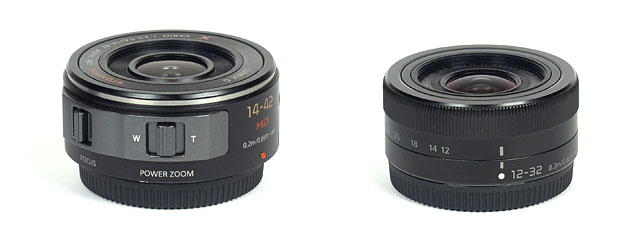|
Panasonic Lumix G Vario 12-32mm f/3.5-5.6 ASPH Mega O.I.S. - Review / Lens Test Report |
|
Lens Reviews -
(Micro-)Four-Thirds
|
|
Page 1 of 3
Review by Klaus Schroiff, published May 2014

Introduction
The Micro Four-Thirds system is a bit in a vulnerable position these days. They are receiving increasing heat from Fujifilm and Sony in the high end sector and due to the smaller sensor size this is probably going to be a difficult battle in terms image quality potential. From the bottom end, smartphones are at least attracting less ambitious users. Finding new value propositions is therefore key. Panasonic and Olympus are keeping a bit of an edge in certain aspects - namely AF speed and movie capabilities. However, at least Panasonic rediscovered an old advantage - system size and weight. Now MFT was never big for sure but earlier this year they released the Panasonic GM1 - a breathtakingly small camera which is barely bigger than digicams while still providing an excellent performance. The GM1 is also offered with a new kit lens - the Panasonic Lumix G 12-32mm f/3.5-5.6 ASPH Mega OIS. The lens is interesting in at least three aspects:
- it is a pancake zoom lens and as such extremely small in transport mode
- it is a bit wider than usual. In full format terms it provides a field-of-view equivalent to "24-64mm".
- Panasonic published some rather unreal MTFs (contrast & resolution characteristic) on their website.
So it may be a devilish beast in a tiny form factor ... we'll see.
 The build quality of the Panasonic lens is about average and somewhat worse than its in-house cousin, the Panasonic Lumix G X 14-42mm f/3.5-5.6 PZ Power OIS. The lens body is made of plastics based on a metal mount. As already mentioned the lens is tiny in transport mode. You can switch it to shooting mode by turning the zoom ring beyond a click mark (the 12mm setting). This extends the lens significantly and only then it becomes apparent that it is a duo-cam design (two inner lens tubes). The inner-most tube wobbles slightly and, to be honest, the lens feels a bit fragile when fully extended. The zoom ring itself is fairly stiff and tight. A specialty is the focus ring ... or to be precise - the lack thereof. This is probably not an issue in this lens class but this implementation relates more to digicam- rather than system-lenses.
The build quality of the Panasonic lens is about average and somewhat worse than its in-house cousin, the Panasonic Lumix G X 14-42mm f/3.5-5.6 PZ Power OIS. The lens body is made of plastics based on a metal mount. As already mentioned the lens is tiny in transport mode. You can switch it to shooting mode by turning the zoom ring beyond a click mark (the 12mm setting). This extends the lens significantly and only then it becomes apparent that it is a duo-cam design (two inner lens tubes). The inner-most tube wobbles slightly and, to be honest, the lens feels a bit fragile when fully extended. The zoom ring itself is fairly stiff and tight. A specialty is the focus ring ... or to be precise - the lack thereof. This is probably not an issue in this lens class but this implementation relates more to digicam- rather than system-lenses.
 The AF performance of the lens is pretty much excellent and essentially silent. Despite the dwarfish size Panasonic managed to include an optical image stabilizer ("Mega O.I.S."). It is good enough for about 3 f-stops depending on your addiction to coffee (yes, I am a coffee junkie ...).
Here's a comparison to the Panasonic Lumix G X 14-42mm f/3.5-5.6 PZ Power OIS (to the left) with both lenses in transport mode.
The AF performance of the lens is pretty much excellent and essentially silent. Despite the dwarfish size Panasonic managed to include an optical image stabilizer ("Mega O.I.S."). It is good enough for about 3 f-stops depending on your addiction to coffee (yes, I am a coffee junkie ...).
Here's a comparison to the Panasonic Lumix G X 14-42mm f/3.5-5.6 PZ Power OIS (to the left) with both lenses in transport mode.

| Specifications |
|---|
| Equiv. focal length | 24-62 mm (full format equivalent) |
| Equiv. aperture | f/7-f/11.2 (full format equivalent in terms of depth-of-field) |
| Optical construction | 8 elements in 7 groups inc. 3x aspherical and 1xED elements |
| Number of aperture blades | 7 (circular) |
| min. focus distance | 0.2-0.3m (max. magnification 1:7.7) |
| Dimensions "on/off" (L x W) | 24x55mm (in transport mode) |
| Weight | 70g |
| Filter size | 37mm (non-rotating) |
| Hood | No |
| Other features | Mega OIS, retractable |
|